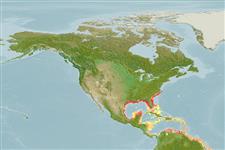Environment: milieu / climate zone / depth range / distribution range
Ecology
Marine; demersal; depth range 9 - 31 m (Ref. 40824). Subtropical
Western Atlantic: restricted to the northern and western Gulf of Mexico.
Size / Weight / Age
Maturity: Lm ? range ? - ? cm
Max length : 31.0 cm TL male/unsexed; (Ref. 7251)
Short description
Morphology | Morphometrics
Entire dorsal surface of the body covered with polkadot-like pattern of dark spots. Allometric growth of the rostrum: a relatively long rostrum in small specimens and sometimes a merely knoblike in large ones. Has a wider mouth than cubifrons. Lateral line scale count: subopercular usually 9, cheek series 9. Ventral surface of pectoral fin rays thickened with fleshy pads (Ref. 40824).
Life cycle and mating behavior
Maturity | Reproduction | Spawning | Eggs | Fecundity | Larvae
Bradbury, M.G., 1980. A revision of the fish genus Ogcocephalus with descriptions of new species from the western Atlantic Ocean (Ogcocephalidae: Lophiiformes). Proc. Calif. Acad. Sci. 42(7):229-285. (Ref. 40824)
IUCN Red List Status (Ref. 130435)
Threat to humans
Harmless
Human uses
More information
Common namesSynonymsMetabolismPredatorsEcotoxicologyReproductionMaturitySpawningSpawning aggregationFecundityEggsEgg development
Age/SizeGrowthLength-weightLength-lengthLength-frequenciesMorphometricsMorphologyLarvaeLarval dynamicsRecruitmentAbundanceBRUVS
ReferencesAquacultureAquaculture profileStrainsGeneticsElectrophoresesHeritabilityDiseasesProcessingNutrientsMass conversion
Tools
Special reports
Download XML
Internet sources
Estimates based on models
Preferred temperature (Ref.
123201): 23.2 - 27.5, mean 24.3 °C (based on 142 cells).
Phylogenetic diversity index (Ref.
82804): PD
50 = 0.5001 [Uniqueness, from 0.5 = low to 2.0 = high].
Bayesian length-weight: a=0.02291 (0.00925 - 0.05675), b=2.94 (2.72 - 3.16), in cm total length, based on LWR estimates for this (Sub)family-body shape (Ref.
93245).
Trophic level (Ref.
69278): 3.5 ±0.6 se; based on size and trophs of closest relatives
Resilience (Ref.
120179): Low, minimum population doubling time 4.5 - 14 years (Preliminary K or Fecundity.).
Fishing Vulnerability (Ref.
59153): Low vulnerability (21 of 100).
